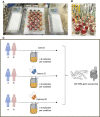A Microbiota-Dependent Response to Anticancer Treatment in an In Vitro Human Microbiota Model: A Pilot Study With Hydroxycarbamide and Daunorubicin
- PMID: 35719352
- PMCID: PMC9198576
- DOI: 10.3389/fcimb.2022.886447
A Microbiota-Dependent Response to Anticancer Treatment in an In Vitro Human Microbiota Model: A Pilot Study With Hydroxycarbamide and Daunorubicin
Abstract
Background: Anticancer drug efficacy is linked to the gut microbiota's composition, and there is a dire need to better understand these interactions for personalized medicine. In vitro microbiota models are promising tools for studies requiring controlled and repeatable conditions. We evaluated the impact of two anticancer drugs on human feces in the MiniBioReactor Array (MBRA) in vitro microbiota system.
Methods: The MBRA is a single-stage continuous-flow culture model, hosted in an anaerobic chamber. We evaluated the effect of a 5-day treatment with hydroxycarbamide or daunorubicine on the fecal bacterial communities of two healthy donors. 16S microbiome profiling allowed analysis of microbial richness, diversity, and taxonomic changes.
Results: In this host-free setting, anticancer drugs diversely affect gut microbiota composition. Daunorubicin was associated with significant changes in alpha- and beta-diversity as well as in the ratio of Firmicutes/Bacteroidetes in a donor-dependent manner. The impact of hydroxycarbamide on microbiota composition was not significant.
Conclusion: We demonstrated, for the first time, the impact of anticancer drugs on human microbiota composition, in a donor- and molecule-dependent manner in an in vitro human microbiota model. We confirm the importance of personalized studies to better predict drug-associated-dysbiosis in vivo, linked to the host's response to treatment.
Keywords: MBRA; anticancer treatment and bacteria; daunorubicin; gut microbiota; hydroxycarbamide; in vitro microbiota model.
Copyright © 2022 Hobson, Vigué, Magnan, Chassaing, Naimi, Gachet, Claraz, Storme, Bonacorsi, Tenaillon and Birgy.
Conflict of interest statement
The authors declare that the research was conducted in the absence of any commercial or financial relationships that could be construed as a potential conflict of interest.
Figures






References
Publication types
MeSH terms
Substances
LinkOut - more resources
Full Text Sources

